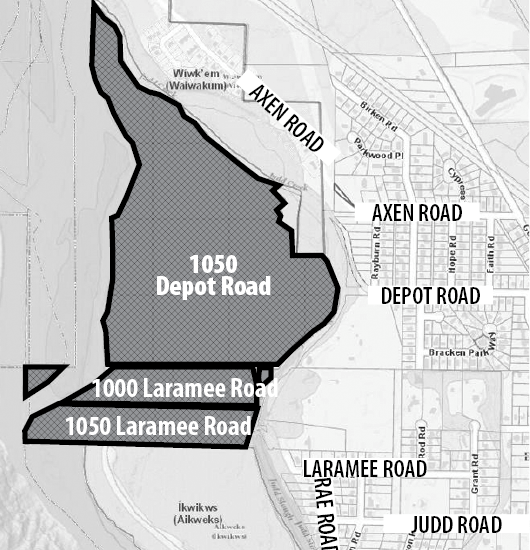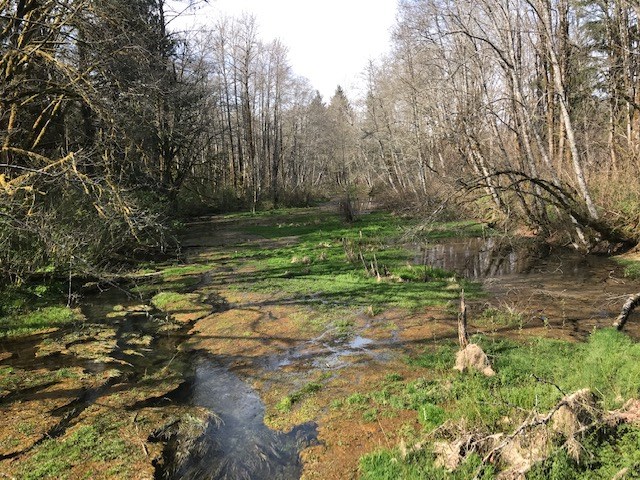To cut density in what it considers to be high-flood hazard areas, District council has passed third reading on bylaws that would convert three properties into agricultural land.
Council voted unanimously in favour of those bylaws on Sept. 14. These proposed regulations still have to pass adoption, but that is a near certainty after third reading is granted.
The affected properties are 1000 and 1050 Laramee Road, as well as 1050 Depot Road, which, according to municipal staff, have an unacceptable risk of flooding that could result in loss of life.
A public hearing for the rezoning took place immediately before third reading, with some owners of the properties expressing concerns about the proposed changes.
“There is no valid research on the type of agriculture you are proposing — nonetheless — the property is divided by Judd Slough and is in no way feasible for agriculture,” said Silvia Smithers, who identified herself as having “an invested interest” in 1050 Depot Road. “You are restricting the options for this property considerably by changing the zoning to agriculture from recreational use.”
The proposed changes are just part of a larger zoning overhaul that has been underway with the aim of better aligning zoning with the municipality’s Official Community Plan (OCP).

Monday’s public hearing for the Brackendale properties was delayed due to complications with the administrative process, said community planner Matt Gunn during the meeting. It was originally supposed to be given a hearing in late July. Staff recommends changing the zoning for the three pieces of land to Agriculture 3, which would allow for agriculture, houses, horse stables, indoor riding arenas and kennels, in order to keep the area low density.
A 2018 risk assessment indicated that the risk of death from flooding was “unacceptable” even if a dike was upgraded to a 1-in-500 year standard.
“Less people and development in high-hazard areas is one of the best ways to reduce risk,” said David Roulston, manager of municipal infrastructure for the district. “Staff believes low-intensity land use is best for this area.”
Smithers, meanwhile, disagreed.
“Understanding that there is a growth-management issue in Squamish, these zoning changes are not benefiting the community,” she said. “Why limit the properties outlined to agriculture when there is a continued interest and need for recreational areas. There are no benefits to changing the zoning — not only the time, effort and dissipation of taxpayers’ money moving forward and how exactly can you justify a zone change since there is no need to rezone the current neighbourhood and appears to be a form of spot zoning.”
In a letter to council, Carl Halvorson and Leona Murray, who own property on Laramee Road by which 1000 and 1050 Laramee Road are accessed through an easement that crosses their land, said they support the changes, but with a few caveats.
They were concerned the termination of the existing land-use contract could mean septic tanks and private wells might no longer be allowed on the neighbouring lands, meaning access to sanitary services or potable water would have to cross their land.
“We are not willing to allow expansion of the existing potable water trespass on our land, nor installation of sanitary services, as both would be incumbrances to the use, enjoyment and value of our land,” they write.
On top of that, they worry the existing easement, meant to allow access between neighbours, would see more traffic from
the public.
“We support any zoning that would limit the scope of development on 1000 and 1050 Laramee to their existing form and character,” the letter said.
“Allowing retail sales could create significant increases of public access across our land, would increase our exposure to liability and would result in changes in the form and character of what has always been a casual country laneway.”
After council heard feedback in the public meeting, they gave all six proposed bylaws third reading.
“I believe the fundamental issue with all these bylaws we’re looking at tonight is due diligence in… extremely hazardous conditions,” said Coun. Eric Andersen. “Due diligence with natural hazard is a unique priority in our OCP. We have also discussed aligning with provincial guidelines … It’s very important for the municipality to take issues of natural hazards very seriously.”



